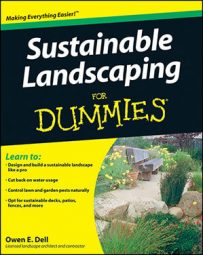A key component of a sustainable landscape is water conservation. Ideally, creating a landscape that requires no, or very little irrigation, is the most sustainable option and it’s certainly possible. Use the following water-saving practices when planning your landscape:
Pay attention to design. Group plants into hydrozones (areas containing plants with similar water needs) to ensure you aren’t wasting water.
Choose drought-tolerant plants. Select species that are climate-appropriate and that will thrive on rainfall alone or with very little supplemental irrigation.
Downsize your lawn. The lawn is the big water-sucker in your landscape. Try reducing the size of your lawn to just what you actually use.
Harvest rainwater. The best water for your garden falls out of the sky, so why not gather it? Even something as simple as digging a swale to channel your rainwater or connecting a rain barrel to your downspout can help save water.
Irrigate efficiently. Drip irrigation (a type of watering system that applies water directly and slowly to the soil) or judicious hand watering are the best ways to irrigate.
Use mulch. Mulch is a layer of organic matter, usually wood chips or bark, that’s placed on top of the soil surface. It conserves water by reducing evaporative loss from the soil surface, keeping the roots of the plants cool, and reducing weeds that compete with desirable plants for water.
Manage your landscape with conservation in mind. Run your garden the smart way. Keep weeds down. Top off mulch as needed to maintain a 3- to 4-inch thick layer. Check your irrigation system monthly for proper operation, and then make any necessary repairs as soon as you can. Reprogram your irrigation controller as needed to adjust for seasonal differences in water use.

